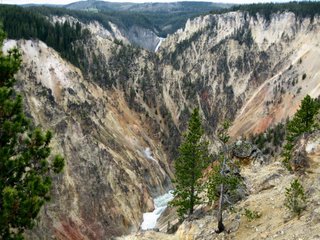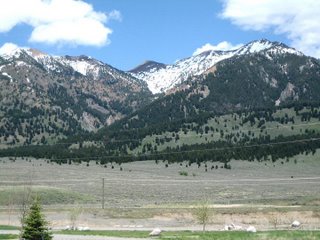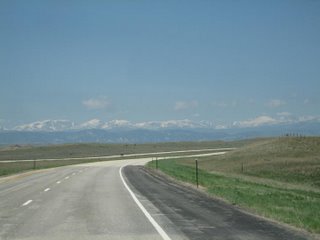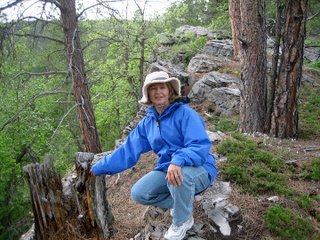It is a unique feeling to be around the demonstration of live volcanism around Yellowstone. It makes you wonder just when - or if - it will become active again. Our campground manager was telling us of the routine tremors that they experience. We saw catastrophic and fatal evidence of the unstable terrain along the road from our Howling Mad Moon campground some 30 miles North West of Yellowstone.
The Madison river drops from Yellowstone and passes close to our campground. As we drive the road that climbs to Yellowstone following the Madison we come to an area where the newly formed Earthquake Lake spills into the Madison rapids below. This lake did not exist until 1985 when an earthquake caused a mountain to slide on top of the madison and a campground there. The slide in the middle of the night buried alive many sleeping RVers and totally dammed the Madison, forming the the lake. The US Core of Engineers had to blast a spillway to drain the lake and prevent further flooding.
As we approached Yellowstone from the West, we began seeing the edge of the enormous caldera from the super-volcano that exploded here.

(Double-click pictures to enlarge)

The Caldera rim is a ring of low hills and mountains. Inside the caldera the earths crust is thin, and a dome of molten lava which was part of the super-volcano is close to the earths surface.
Inside the caldera, the melting waters of heavy winter snows, at this elevation of 7000 to 8000 feet, seep underground closer to the heat of the molten lava dome. Steam and boiling water is everywhere.


You can see the crusty surface around the steamers and geysers in the pictures above. A number of people have walked on the thin crust and fallen to their death into boiling water . The funny thing is that we could see the two-toed hoof prints (and poop mounds) from elk, moose, and bison roaming in these dangerous areas.
 (Double click to enlarge pictures)
(Double click to enlarge pictures)

 Looking through this snaking gorge, I felt like a spec in this magnificent canyon and river. While we are all doing something else, this river continues to rage through these mountains of rock.
Looking through this snaking gorge, I felt like a spec in this magnificent canyon and river. While we are all doing something else, this river continues to rage through these mountains of rock.
































 Along the way, we saw many large herds of Black Angus cows. This group has been gathered together, but more common is seeing hundreds of head of cattle grazing in large pastures.
Along the way, we saw many large herds of Black Angus cows. This group has been gathered together, but more common is seeing hundreds of head of cattle grazing in large pastures.






